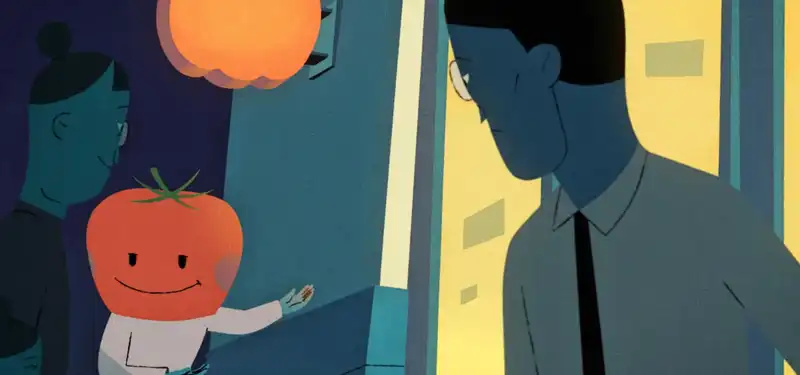Aug 28, 2023
2024 Academy Award Nominee for Best Short Film: “Tomato Kitchen” directed by Junyi Hsiao
Welcome to Cartoon Brew's spotlight series highlighting animated short films that have qualified for the 2024 Academy Awards. There are several ways for a film to qualify for an award. In this edition, we will focus on films that have won an Oscar-eligible award at a festival that is eligible for the Academy Awards.
Today's short film is “Tomato Kitchen,” directed by Junyi Xiao. The film was produced by Studio Reflection as part of the Chinese platform Bilibili's anthology series Capsules. “Tomato Kitchen” won the ChileMono International Animated Film Festival in Santiago, Chile for Best International Animated Short Film Award at the ChileMono International Animated Film Festival in Santiago, Chile, and qualified for an Academy Award.
“Tomato Kitchen” is an allegory about race and identity, in which the main human character is having a meal with his colleagues when an accident occurs. The unexpected event reveals the dark truth about Tomato Kitchen and the protagonist's hidden past.
Cartoon Brew: Your film touches on a profound social theme that has been bubbling under the surface for years but became widely recognized during the pandemic. Junyi Xiao (Junyi Xiao): I started writing the script a long time ago. Initially, it was a story about watermelons. People became so obsessed with eating watermelons that their heads turned into watermelons. In Chinese culture, a spectator mindlessly following an online fad is called “.
However, a number of social events between 2020 and 2022 gradually changed the creative direction of the script. Rather than identifying a specific moment or event that made me feel that “now is the time to create the story of Tomato Kitchen,” it is more accurate to say that the social atmosphere of both China and the United States during the Covid period made me believe that it was necessary to make a film that addressed the common challenges faced by marginalized groups.
I am Chinese and moved to the US for school in 2014. I have lived in Los Angeles for almost 9 years and I have yet to successfully assimilate into the mainstream. When I was in China, as a heterosexual male, I was part of the majority of society. However, in the United States, my identity as an Asian placed me in the minority realm. This change in identity provided me with an opportunity to observe aspects of myself that I had previously overlooked and to look at myself from a new perspective.
In the story of “Tomato Kitchen,” the protagonist is also a man who has struggled to fit into the mainstream. I invested much of myself into this character. But at the same time, I wanted to leave room for the audience to decipher the film. It is my hope that this film will be a vessel into which every member of the audience can insert their own experiences and understandings.
What did you learn through the experience of making this film, either in terms of production, filmmaking, creativity, or subject matter? However, “Tomato Kitchen” is the result of a collaborative process. There were many challenges, especially during the pandemic. Team members were scattered all over the world, and I had to manage schedules and adjust to time zones. Working as a producer as well as a director was a valuable learning experience for me. Over time, I came to understand that filmmaking is the art of communication. Not only is it important to ensure that the film connects with the audience, but also to ensure seamless communication in all departments behind the scenes.
How did you develop your visual approach to this film and why did you settle on this style/method? In my opinion, there are two approaches to immersing the audience in the world of the story. One is to use extremely realistic production design with extensive CG like in “Avatar,” which, frankly, is beyond my budget and resources. The other is to use stylized design and aesthetics to incorporate the unique characteristics of animation. This way, the audience can more easily accept the fictional nature of the story. This approach suited our situation better, so we settled on the film's art style. The character designs are not hyper-realistic, but they do not hinder the audience's emotional involvement. Similarly, the environmental design is not as detailed, but still manages to convey the somber atmosphere of the story.
.



Post your comment